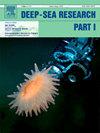Constraining sulfur and iron cycling in seep systems: insights from authigenic pyrite signatures
IF 2.1
3区 地球科学
Q2 OCEANOGRAPHY
Deep-Sea Research Part I-Oceanographic Research Papers
Pub Date : 2025-07-02
DOI:10.1016/j.dsr.2025.104552
引用次数: 0
Abstract
Seep activity has emerged as a critical area of research for understanding biotic communities and elemental cycling (e.g., carbon, sulfur and iron) in deep extreme environments. While previous studies have predominantly focused on sulfur isotopes in pyrite as a proxy for seep activity, recent advancements highlight the potential of iron isotopes as an additional indicator. However, the detailed mechanism of how sulfur and iron coupled in seep environment is still unclear and thus hamper the further constraint of seep activity by these two key elements. For this reason, the authors analyzed 25 samples from three sediment cores which are collected from seepage sites in the Taixinan Basin (core 973–4) and the Pearl River Mouth Basin (cores GG03 and Z22-3) in the Northern South China Sea. By using SEM-EDS analysis and in-situ sulfur (δ34S) and iron (δ56Fe) isotope measurements, also combining with results from previous studies, the evolution patterns of sulfur and iron in seep environments is explored. The δ34S values of pyrite in core 973–4 range from −18.79 ‰ to 27.26 ‰, indicating a closed-system seep activity. In contrast, pyrite in cores GG03 and Z22-3 exhibit significantly negative δ34S values (−49.75 ‰ to −46.29 ‰ and −53.88 ‰ to −37.11 ‰, respectively), characteristic of more open-system seep activities. Additionally, the δ56Fe values of pyrite are consistently negative across all cores (−1.39 ‰ to −0.31 ‰ in core 973–4, −1.59 ‰ to −0.24 ‰ in core GG03, and −1.10 ‰ to −0.20 ‰ in core Z22-3), suggesting the absence of a heavy iron isotope pool. By integrating these findings with previous results, this study demonstrates that the δ56Fe values of pyrite are influenced by the position of the sulfate-methane transition zone, diverse microbial reduction processes, and varying iron sources. Therefore, this study provides valuable data to decipher how coupled sulfur and iron evolving in seep environments by pyrite, enhancing the further understanding of elemental cycles in extreme settings.
渗漏系统中限制硫和铁循环:来自自生黄铁矿特征的见解
渗漏活动已成为了解深层极端环境中生物群落和元素循环(如碳、硫和铁)的关键研究领域。虽然以前的研究主要集中在硫铁矿中的硫同位素作为渗漏活动的代理,但最近的进展强调了铁同位素作为附加指标的潜力。然而,硫和铁在渗流环境中耦合的具体机制尚不清楚,从而阻碍了这两个关键元素对渗流活动的进一步约束。为此,作者对南海北部台南盆地(973-4号)和珠江口盆地(GG03和Z22-3号)渗漏点3个沉积物岩心的25个样品进行了分析。通过SEM-EDS分析和原位硫(δ34S)和铁(δ56Fe)同位素测量,并结合前人研究结果,探讨了渗流环境中硫和铁的演化模式。974 - 4岩心黄铁矿的δ34S值在−18.79‰~ 27.26‰之间,显示出封闭体系的渗流活动。而GG03和Z22-3岩心黄铁矿δ34S值显著负(分别为- 49.75‰~ - 46.29‰和- 53.88‰~ - 37.11‰),具有较强的开放体系渗流活动特征。此外,黄铁矿的δ56Fe值在所有岩心中均为负(974 - 4为- 1.39‰~ - 0.31‰,GG03为- 1.59‰~ - 0.24‰,Z22-3为- 1.10‰~ - 0.20‰),表明不存在重铁同位素池。综合前人的研究结果,本文认为黄铁矿的δ56Fe值受硫酸盐-甲烷过渡带位置、不同微生物还原过程和不同铁源的影响。因此,本研究提供了有价值的数据来解释硫铁矿在渗漏环境中耦合的硫和铁是如何演化的,增强了对极端环境下元素循环的进一步理解。
本文章由计算机程序翻译,如有差异,请以英文原文为准。
求助全文
约1分钟内获得全文
求助全文
来源期刊
CiteScore
4.60
自引率
4.20%
发文量
144
审稿时长
18.3 weeks
期刊介绍:
Deep-Sea Research Part I: Oceanographic Research Papers is devoted to the publication of the results of original scientific research, including theoretical work of evident oceanographic applicability; and the solution of instrumental or methodological problems with evidence of successful use. The journal is distinguished by its interdisciplinary nature and its breadth, covering the geological, physical, chemical and biological aspects of the ocean and its boundaries with the sea floor and the atmosphere. In addition to regular "Research Papers" and "Instruments and Methods" papers, briefer communications may be published as "Notes". Supplemental matter, such as extensive data tables or graphs and multimedia content, may be published as electronic appendices.

 求助内容:
求助内容: 应助结果提醒方式:
应助结果提醒方式:


